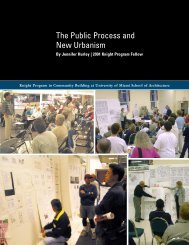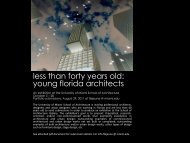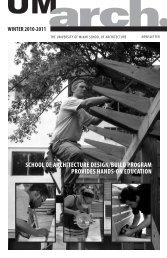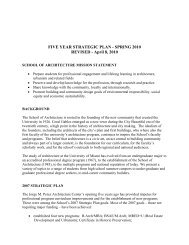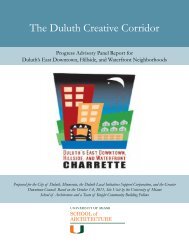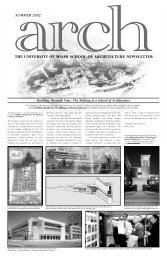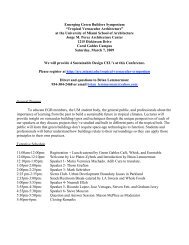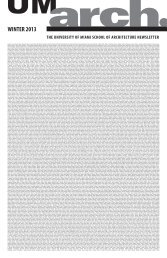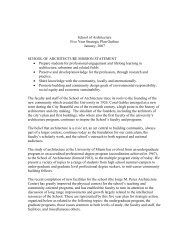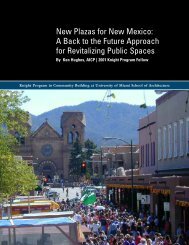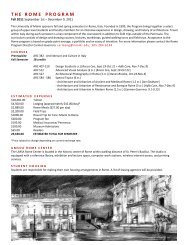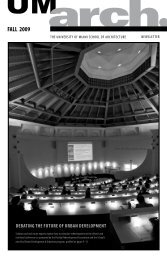Resilience - University of Miami School of Architecture
Resilience - University of Miami School of Architecture
Resilience - University of Miami School of Architecture
You also want an ePaper? Increase the reach of your titles
YUMPU automatically turns print PDFs into web optimized ePapers that Google loves.
7.<br />
Program Framework<br />
An essenal characterisc <strong>of</strong> good architecture is the integraon <strong>of</strong> mulple<br />
disparate program requirements into a unified composion. I will use the<br />
several meanings <strong>of</strong> resilience as a means <strong>of</strong> organizing the programming<br />
phase <strong>of</strong> this project. As defined at the beginning <strong>of</strong> this document, resilience<br />
– is the capacity <strong>of</strong> a given ecosystem to maintain its essenal characteriscs<br />
despite stressors including changing environmental condions.<br />
Addressing the definion given above, there are three components. First I<br />
will work with RSMAS to create a working list <strong>of</strong> “essenal characteriscs”<br />
which define two ecosystems; one, the Virginia Key/Bear Cut coastal margin,<br />
and two, the <strong>University</strong> community which I view as part <strong>of</strong> the Virginia Key<br />
system. Second, I will outline expected system-level stressors. Third, I will<br />
idenfy those which may be migated through architecture.<br />
program criteria<br />
A truly resilient campus will sasfy a broad range <strong>of</strong> program needs. In the<br />
largest sense, the goal is to create a place which supports a thriving intellectual<br />
community in a manner which is integrated into its urban and ecological context.<br />
Improvements to the RSMAS campus should be evaluated in the context<br />
<strong>of</strong> campus planning needs, but also for how they contribute to the enrichment<br />
<strong>of</strong> the larger Viginia Key/Bear Cut ecosystem. Campus planning for RSMAS<br />
should consider basic issues such as parking and transportaon in conjunc-<br />
on with adjacent facilies, development <strong>of</strong> pedestrian and bicycle networks,<br />
public waterfront access, visibility <strong>of</strong> RSMAS campus funcons to the public,<br />
and program diversificaon including addion <strong>of</strong> housing and compelling community<br />
spaces.<br />
Beyond this, campus improvements should be designed to enhance the interface<br />
with Bear Cut. Improvements should go beyond a generalized low-impact<br />
building approach, and target enhancement <strong>of</strong> specific ecological funcons.<br />
For example, green ro<strong>of</strong>s could be designed to provide habitat for shorebird<br />
species which would have found refuge in the nave coastal scrub forest.<br />
Buildings could be connected by elevated walkways which would allow<br />
for restoraon <strong>of</strong> seasonal flooding on parts <strong>of</strong> the campus and replanng <strong>of</strong><br />
funconal pockets <strong>of</strong> mangrove. By idenfying quanfiable ecological goals,<br />
input from disciplines such as restoraon ecology is given greater weight in the<br />
design process.<br />
client<br />
Because <strong>of</strong> their centralized structure, informed decision making process, long<br />
planning horizons, and respect for innovaon, universies can play a unique<br />
role in seng the tone for future development <strong>of</strong> surrounding communies.<br />
The Rosensel campus <strong>of</strong>fers an opportunity to test the potenal for thoughtful,<br />
humane, and ecologically sensive coastal urban redevelopment. As with<br />
any instuonal client, various interests must be balanced in order to create<br />
a campus which opmizes benefit to the larger community while serving the<br />
specific programmac needs <strong>of</strong> its members. In this instance, there are three<br />
primary client interests:<br />
• The <strong>University</strong> <strong>of</strong> <strong>Miami</strong> as a whole<br />
• Specific interests <strong>of</strong> the Rosensel <strong>School</strong> <strong>of</strong> Marine and Atmospheric<br />
Sciences<br />
• The Virginia Key ecosystem<br />
A successful program will have to balance the somemes conflicng needs <strong>of</strong><br />
the three communies above. A successful design will both reinforce the essenal<br />
characteriscs <strong>of</strong> the three, as well as improve their resilience to future<br />
stress. Preliminary quesons are as follows:<br />
university priories<br />
• How can RSMAS be beer integrated into the academic and social life<br />
<strong>of</strong> students on Main Campus?<br />
• How can RSMAS campus facilies be improved to provide opportuni-<br />
es for students from a variety <strong>of</strong> disciplines to study coastal issues in<br />
an integrated manner?<br />
• Could an improved RwSMAS campus serve as a recruing tool for the<br />
larger <strong>University</strong>?<br />
• Can the RSMAS campus reflect the President’s desire to incorporate<br />
housing into new <strong>University</strong> structures?<br />
rsmas priories<br />
• How can new construcon improve spaal definion <strong>of</strong> the campus,<br />
helping describe a hierarchical sequence <strong>of</strong> posive open spaces?<br />
• How can infrastructure, ulies and circulaon be streamlined?<br />
• What kinds <strong>of</strong> spaces are needed to improve the funcon <strong>of</strong> the<br />
research community?<br />
• How can obsolete structures best be replaced?<br />
• What combinaons <strong>of</strong> program would be most easily financed?<br />
• What kinds <strong>of</strong> non-academic program would improve campus life (ie.<br />
housing, community space?)<br />
• If housing were to be added, what type and how many units would<br />
create a crical mass <strong>of</strong> residents?<br />
• How can physical improvements impact the durability <strong>of</strong> RSMAS as a<br />
human community focused on top-level marine ecological research<br />
and conservaon?<br />
27




